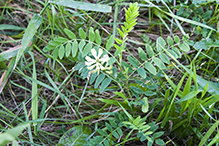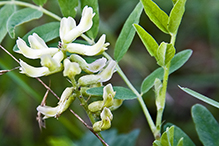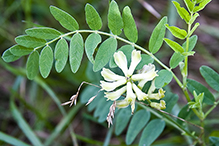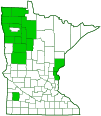Cooper’s milkvetch
(Astragalus neglectus)
Conservation • Wetland • Description • Habitat • Ecology • Use • Distribution • Taxonomy
Description |
||
Cooper’s milkvetch is a 12″ to 36″ tall, erect, perennial forb rising on a cluster of stems from a taproot. The stems are more or less erect, branching, leafy, usually hollow, and hairless or nearly hairless. The leaves are alternate and pinnately divided into 11 to 23 leaflets. Each leaf has a terminal leaflet and an odd total number of leaflets. There is an egg-shaped, pointed, ⅛″ to ⅜″ long stipule at the base of each leaf stalk. The leaflets are oblong to inversely egg-shaped and ⅜″ to 1 3 ⁄16″ long. The lower surface of the leaf blade is covered with straight, stiff, sharp, appressed hairs. The inflorescence is several short, unbranched clusters (racemes) of 10 to 20 stalked flowers rising on a stalk from the leaf axils. The stalk and raceme together barely surpass in length the subtending leaf. The flowers are 7 ⁄16″ to ⅝″ long. There are 5 sepals fused for most of their length into a ⅛″ to 3 ⁄16″ long, cylinder-shaped tube (calyx), then separated into 5 lobes about half as long as the tube. The 5 petals are white to cream colored and form a butterfly-like corolla, as is typical of plants in the Pea family. They are organized into a broad banner petal at the top, two lateral wing petals, and between the wings two petals fused into a keel. The banner is notched at the tip. The fruit is an inflated, spindle-shaped or egg-shaped, ⅝″ to ¾″ long, 5 ⁄16″ to 11 ⁄16″ wide seed pod. The pod is stalkless and straight. It is held erect or spreading, not drooping. |
||
Height |
||
12″ to 36″ |
||
Flower Color |
||
White to cream |
||
Similar Species |
||
Habitat |
||
Lake shores, stream banks, river banks. Full to partial sun. |
||
Ecology |
||
Flowering |
||
June to July |
||
Pests and Diseases |
||
|
||
Use |
||
|
||
Distribution |
||||
|
Sources |
|||
| 3/21/2023 | ||||
Nativity |
||||
Native |
||||
Occurrence |
||||
|
||||
Taxonomy |
|||
| Kingdom | Plantae (Plants) | ||
| Division | Tracheophyta (Vascular Plants) | ||
| Subdivision | Spermatophytina (Seed Plants) | ||
| Class | Magnoliopsida (Dicots) | ||
Order |
Fabales (Legumes, Milkworts, and Allies) | ||
Family |
Fabaceae (Legumes) | ||
| Subfamily | Faboideae | ||
| Tribe | Galegeae (milkvetches, locoweeds, and allies) | ||
| Subtribe | Astragalinae | ||
| Genus | Astragalus (milkvetches) | ||
Subordinate Taxa |
|||
|
|||
Synonyms |
|||
Astragalus cooperi Phaca neglecta |
|||
Common Names |
|||
Cooper’s milk-vetch Cooper’s milkvetch |
|||
Glossary
Axil
The upper angle where the leaf stalk meets the stem.
Calyx
The group of outer floral leaves (sepals) below the petals, occasionally forming a tube.
Caudex
A short, thickened, woody, persistent enlargement of the stem, at or below ground level, used for water storage.
Pinnate
On a compound leaf, having the leaflets arranged on opposite sides of a common stalk. On a bryophyte, having branches evenly arranged on opposite sides of a stem.
Raceme
An unbranched, elongated inflorescence with stalked flowers. The flowers mature from the bottom up.
Sepal
An outer floral leaf, usually green but sometimes colored, at the base of a flower.
Stipule
A small, leaf-like, scale-like, glandular, or rarely spiny appendage found at the base of a leaf stalk, usually occurring in pairs and usually dropping soon.
Visitor Photos |
|||||
Share your photo of this plant. |
|||||
| This button not working for you? Simply email us at info@MinnesotaSeasons.com. Attach one or more photos and, if you like, a caption. |
|||||
|
|||||
MinnesotaSeasons.com Photos |
|||||
Plant |
|||||
 |
|||||
Inflorescence |
|||||
 |
|||||
Leaves |
|||||
 |
|||||

Slideshows |
||

Visitor Videos |
|||
Share your video of this plant. |
|||
| This button not working for you? Simply email us at info@MinnesotaSeasons.com. Attach a video, a YouTube link, or a cloud storage link. |
|||
Other Videos |
|||

Visitor Sightings |
|||||
Report a sighting of this plant. |
|||||
| This button not working for you? Simply email us at info@MinnesotaSeasons.com. Be sure to include a location. |
|||||
|
|||||
MinnesotaSeasons.com Sightings |
|||||

|
Created: Last Updated: © MinnesotaSeasons.com. All rights reserved. |
